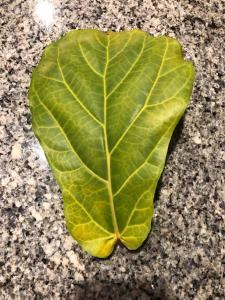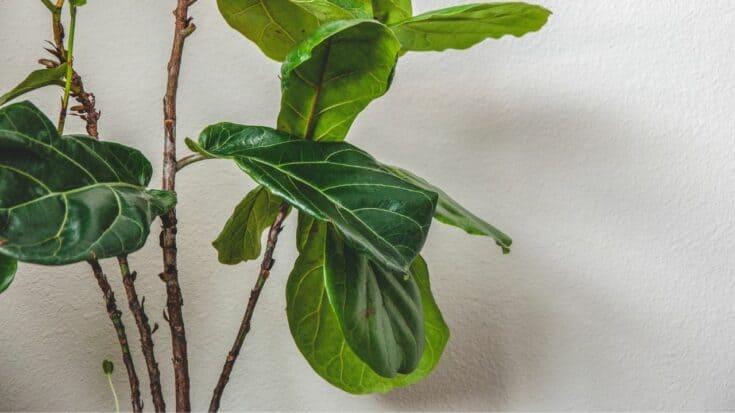A lot of fiddle leaf fig owners find it very scary when they see that their beloved tree has lost a leaf or, gasp, several leaves.
Take a deep breath before you start to worry and water, repot, buy grow lights, put your plant outside, or look for bugs.
The good news is that fiddle leaf figs do drop a leaf or two every once in a while; it’s normal and even good for them.
All plants shed leaves over time because they’re constantly growing new ones. Older leaves might simply drop off as the tree grows new leaves to replace them.
Here are the signs that your fiddle’s leaf dropping is actually healthy and not a cause for concern.
If you’re a proud owner of a fiddle leaf fig, you’ve likely noticed leaves yellowing, curling, and dropping from the bottom portion of the plant. This is a common issue many fiddle leaf fig owners face. But don’t panic – losing bottom leaves is often a natural part of your plant’s growth cycle. With the right care, your fiddle leaf fig can continue to thrive.
What Causes Bottom Leaf Drop?
There are a few key reasons why your fiddle leaf fig sheds its lower leaves:
-
Maturity – As the plant grows taller, less light reaches the bottom leaves. The plant will naturally shed its less efficient leaves over time. This is perfectly normal and not a cause for concern.
-
Underwatering – Fiddle leaf figs prefer consistently moist (but not soggy) soil. Underwatering causes the lower leaves to yellow and dry out. Check that you’re watering enough for your plant’s size, sunlight, temperature, and humidity.
-
Overwatering – Too much moisture can also lead to leaf drop. Ensure the plant’s soil is drying out slightly between waterings.
-
Light conditions – Insufficient light will cause inner and bottom leaves to fall. Fiddle leaf figs thrive in bright, indirect light. Rotate the plant or move it closer to a light source if needed.
-
Root restriction – If the roots are constricted, the plant can’t take up enough water and nutrients. Re-pot in a larger container if roots are crowded.
-
Pests – Spider mites, mealybugs, aphids and other pests can all cause leaf damage and drop. Inspect closely and treat any infestations.
-
Shock – Changes in conditions like moving locations repotting or temperature swings can shock the plant and cause leaf loss. Stabilize conditions and care for it gently while it recovers.
Normalizing Bottom Leaf Drop
The loss of older bottom leaves is very standard in healthy, thriving fiddle leaf figs. As long as it’s not excessive, this natural shedding process allows the plant to focus its energy on new growth. Other signs your plant is doing well include:
- New leaves emerging at the top
- Steady, upright growth
- Deep green leaves without spots or curling
- Avoided extreme stress or changes
You shouldn’t worry about a few yellow leaves here and there on an otherwise strong and vibrant plant. Just adopt proper care habits to minimize leaf loss.
Caring For Your Fiddle Leaf Fig
While some bottom leaf drop is normal, you can take steps to support your plant’s health and minimize excessive leaf loss:
-
Light – Provide bright, filtered light from an east or west facing window. Rotate the plant to evenly distribute light exposure.
-
Water – Allow the top few inches of soil to dry out between waterings. Water thoroughly until it drains from the pot.
-
Humidity – Mist the leaves and use a pebble tray to boost humidity levels.
-
Soil – Use a well-draining potting mix and repot as needed to give roots room.
-
Fertilizer – Feed monthly during spring and summer with a balanced houseplant fertilizer.
-
Pests – Check regularly for pests like mites. Isolate and treat any infestations immediately.
-
Leaf dusting – Gently wipe leaves with a damp cloth to remove dust buildup.
With the right care, your fiddle leaf fig can thrive for years while naturally dropping older leaves. Don’t stress over a few yellow leaves – just focus on consistent water, light, and feeding. And if leaf loss becomes excessive, reevaluate your plant care regimen. A healthy fig will reward you with vigorous growth, brilliant green leaves, and an elegant presence.
When to Worry About Excessive Leaf Loss
While a few bottom leaves naturally yellowing and dropping is normal, excessive or rapid leaf loss is cause for concern.
Signs that indicate a larger underlying problem include:
-
Many leaves yellowing/browning all over the plant
-
Leaf loss combined with weak, limp stems
-
Many leaves dropping within a short time frame
-
Yellowing moving up from older leaves to newer growth
-
Leaf spots, curling, or blackened areas
-
Mushy, translucent leaves
-
Webbing, eggs, or bugs visible on the leaves/stems
If you notice these warning signs, your fiddle leaf fig likely needs an adjustment in care. Common solutions include:
-
Improving lighting conditions
-
Adjusting watering frequency
-
Increasing air circulation and humidity
-
Repotting if rootbound
-
Using warmer temperatures
-
Treating pests or diseases
-
Eliminating drafts or heating vents
-
Applying more gradual changes in environment
With some extra attention and tweaks to care, an unhealthy fig can rebound. But left unchecked, serious leaf drop can lead to permanent damage or death. So if your fiddle leaf fig starts defoliating excessively, it’s important to diagnose and address the underlying issue right away.
Propagating From Leaf Loss
While excessive leaf drop is concerning, those fallen leaves don’t have to go to waste! You can actually propagate new fiddle leaf fig plants from healthy dropped leaves.
Here’s a quick guide:
-
Choose a healthy, mature, undamaged leaf. Avoid diseased leaves.
-
Cut the leaf with about 2-3 inches of stem still attached.
-
Place the cut end into water or moist potting mix.
-
Change the water or mist the soil regularly to prevent drying out.
-
Small roots will begin emerging in a few weeks. Transplant into soil once well-rooted.
-
Keep the new plant warm, humid, and lightly watered as it establishes.
-
In a few months you’ll have a brand new fiddle leaf fig cloned from a dropped leaf!
This simple propagation technique lets you turn leaf loss into new plant babies. So while you strive to keep leaf drop minimal, know that you can reuse those fallen leaves to grow more fiddle leaf figs.
When to Remove Dropped Leaves
Fallen fiddle leaf fig leaves often begin turning yellow as they die and detach. At this point, they are draining resources from the plant without producing energy.
Here are some tips on when to remove dropped leaves:
-
Collect fallen leaves promptly before they start decomposing. Leaving decaying plant matter can encourage pests and diseases.
-
Dry, crispy yellow leaves should be picked up as soon as they drop. They are fully dead and won’t recover.
-
Leaves that are partly yellow but still feel supple may potentially rebound. But remove them if they don’t perk up within a few days.
-
Always isolate dropped leaves with dark brown spots or mushy sections, as these may be diseased.
-
For propagation, choose dropped leaves that are fully green and have no blemishes, cuts, or tears.
-
To encourage new growth, trim off any half-attached dead or dying leaves still hanging onto the plant.
Keeping fallen leaves promptly cleaned up promotes better fiddle leaf fig health. And who knows – you may end up with some bonus propagation projects from usable dropped leaves! With attentive care and quick debris cleanup, your fig can continue growing its iconic, vibrant foliage.
FAQ About Fiddle Leaf Figs Dropping Leaves
Here are answers to some frequently asked questions about managing dropped leaves on a fiddle leaf fig:
How many bottom leaves dropping is normal?
Losing 1-5 mature bottom leaves per year is generally normal. If leaf drop exceeds this or happens rapidly, something may be wrong.
Should I remove dropped leaves right away?
Yes, promptly clean up fallen leaves before they decay to avoid pests and fungi. Yellowed leaves won’t recover once dropped.
Can a fiddle leaf fig recover from heavy leaf drop?
If cared for properly after leaf loss, fiddle leaf figs are remarkably resilient plants that can make strong comebacks.
Do fiddle leaf figs shed leaves before growing new ones?
Fiddle leaf figs don’t rely on cyclic leaf loss before growing new foliage. But they will naturally shed older leaves as the plant matures.
Is my fiddle leaf fig dying if dropping lots of leaves?
Significant leaf loss can be concerning, but doesn’t mean certain death. Evaluate care and troubleshoot potential issues to help it recover.
With the right conditions and care, a fiddle leaf fig can thrive for many years as a gorgeous houseplant. Monitor your plant closely, respond promptly to leaf drop, and propagate when possible from healthy fallen leaves. Your beloved fiddle leaf fig can continue gracing your home with its iconic big, green foliage.
Dropped leaves may be a little yellow
Brown spots are cause for concern, but yellowing on dropped leaves generally isn’t. If your tree has a lot of yellowing leaves, it might be because it is getting too much water and not enough light or fertilizer. On the other hand, if a lower leaf yellows and falls off, it means the tree is done taking care of that leaf.

To sum up, you can relax if your tree drops a lower leaf every once in a while that is mostly plain but maybe a little yellow. Your fiddle is healthy and just carrying out a natural process!.
What Does Normal Leaf Drop for a Fiddle Leaf Fig Look Like?
Because fiddle leaf figs get most of their new growth at the top, the leaves at the bottom are usually the oldest.
Bottom leaves will droop and fall off eventually because the tree doesn’t need them anymore.
If your tree drops a leaf or two from the bottom, don’t panic.
Is Your Fiddle Leaf Fig DROPPING LEAVES?? Do this ASAP!
- The Ultimate Guide to Growing Strawberries in Raised Beds - August 8, 2025
- No-Dig Garden Beds: The Easiest Way to Grow a Beautiful Garden - August 6, 2025
- How to Protect and Preserve Wood for Raised Garden Beds - August 6, 2025

